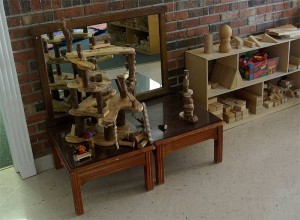Engaged Play in Learning Centers
Importance of Play
Play is a major avenue for learning in the preschool years. Many young children, however, have little experience playing and exhibit immature play skills when they enter early childhood programs. A quality environment for young children must provide enriched opportunities for play that will lead to the learning benefits possible in this important activity.
Small Group
When children participate in small groups they have more opportunities to use language, influence the activity, and share ideas. In this small group fewer disagreements and conflicts occur since only 3-4 children are involved in the play. Therefore, this size group provides a safe place for children to develop skills, expand language and practice working with peers.
 Organizing Centers
Organizing Centers
Learning Centers are an effective way to organize the classroom space to encourage small group participation. The theme or type of activity planned in the center will determine the props and materials that will be included to inspire the related learning, language, and participation. Learning Centers, such as Blocks, work best when a small number of children are working in the area and collaborating on a structure. In this block play learning is integrated as children learn about space relationships, math proportions; develop eye-hand coordination and talking about their construction. They are creatively problem solving as they determine how to build their structure or to make a building stronger. This play is encouraged by having a variety of blocks available, small props, and sufficient space for their building. Sound is absorbed by have a rug on the floor, foam or fabric blocks, and some soft seating.
Socio Dramatic Play
When children are mature players they use their imagination to create a substitute prop which is a symbol for the real object. They will begin to be involved in socio dramatic play considered to be a higher form of interactions. In this play young children create a sequence of events, take on roles, engage in collaboration, and become immersed in their play for long periods of time ( Smilansky & Shefatya, 1990) Many learning centers, where materials are organized around a theme, encourage the development of this form a play. For example, Home Living, a traditional Center, provides the space and materials for children to take on the roles of family members and includes a kitchen where dinner can be prepared. In this play children chose a role, use language related to the home, and stay focused on the sequence of events they have created.
Providing Choices: Creative Thinking
When using learning centers in the classroom it is important for children to choose where they would like to go and to plan what they will do in the area. When children follow their interest their play will be more sustained and engaging. An important step in the process of effectively using center is to provide time to reflect on Center time. This discussion can include posing questions about what children did in the center, what they created, and determining if they want to return to that play scenario tomorrow.
Some Suggestions for Inspiring Center Play:
- Provide Centers (themes) that will match children’s interest and enrich the play.
- Provide sufficient time for in-depth play to occur. (This varies based on children but 40-60 minutes is often suggested)
- Select materials, props, and toys that will support the theme and play. These should change over time.
- Help children plan their play and reflect on it when Center time is concluded. Giving children opportunity to talk about their Center play encourages their involvement.
- Co-play children who need help or pair them with a mature player. Both children grow from the experience where they are the mentor or the mentee.
- Observe and record the children’s play and specific happenings to improve the environments. Writing down what you see helps you make plans and improvements for the Centers. It also provides opportunity to observe “real” learning in action.
Play is a learning activity that should be nurtured in early childhood classrooms. Learning Centers provide the place, props, and peers where this development can occur.
[dt_divider style=”narrow”/]
Bodrova E & Leong, D.J. Tools of the Mind: The Vygotskian Approach to Early Childhood Education. (2007) 2nd edition. Upper Saddle River, New Jersey: Pearson Merrill Prentice Hall.
Isbell, R. (2008). The Complete Book of Learning Centers, revised with CD. Beltsville, MD: Gryphon House.
Smilansky, S. & Shefatya, L. (1990) Facilitating play: A medium for promoting cognitive, socio-emotional and academic development in young children. Gaithersburg, MD: Psychosocial and Educational Publications.
[dt_divider style=”narrow”/]



